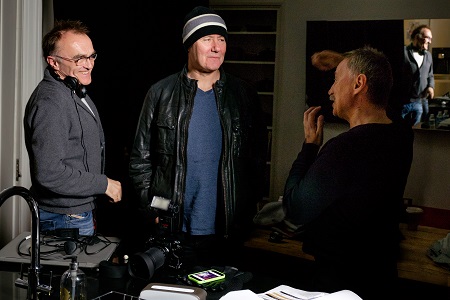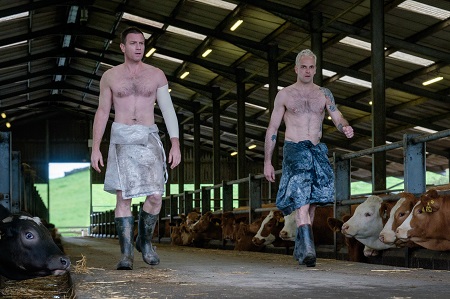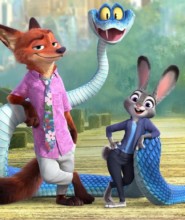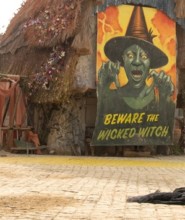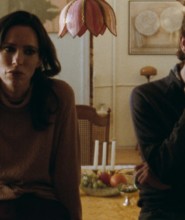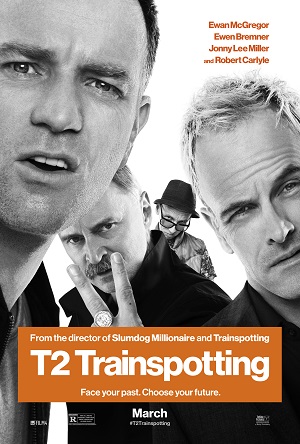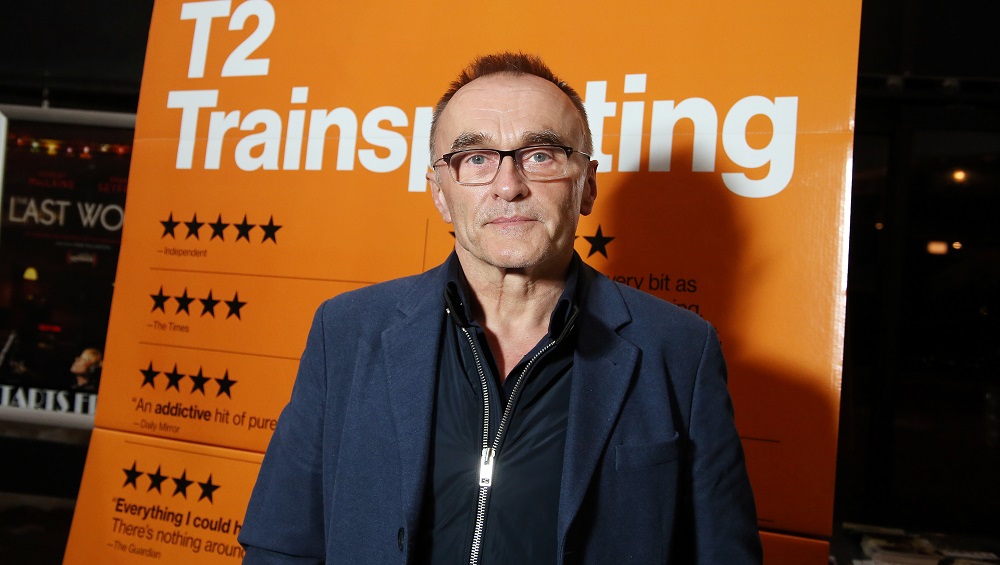
“T2 Trainspottting” – Interview with Danny Boyle
by Sara Michelle Fetters - March 24th, 2017 - Interviews
Understanding the Margins
Danny Boyle on Returning to Trainspotting 20 Years Later
Trainspotting was not director Danny Boyle’s first film, but it was that 1996 adaptation of author Irving Welsh’s best-selling 1993 novel that put him, along with actors Ewan McGregor, Robert Carlyle, Johnny Lee Miller and Ewen Bremner on the proverbial map. It was a stratospheric success story, the movie becoming a cultural phenomenon around the world, even earning an Academy Award nomination for John Hodge’s adapted screenplay.
After 20 years, Boyle, Hodge, McGregor, Carlyle, Miller and Bremner all return for the sequel T2 Trainspotting, a movie fans have long been clamoring for. Picking up with the four main characters now in their 40s, the movie is a surprisingly frank, brutally honest examination of aging, addiction, friendship and family that, while a much different animal than its now classic predecessor, subtly becomes a vital and poignant drama worthy of respect.
I sat down with Boyle during his brief visit to Seattle right before the sequel’s release. Here are some of the highlights from our conversation:
Sara Michelle Fetters: Let’s get the question you’re probably tired of answering out of the way first. Why now? Why wait 20 years to return to the world of Trainspotting?
Danny Boyle: Well, it’s the power of a couple of things, really. The 20-year anniversary is obvious marketing-wise, even though we missed it by a year. It’s been 21 years. It’s still quite a powerful marketing tool.
It was more the fact of the characters. You make some films which are successful and some which are not, but they all fade away. They just fade. It’s just inevitable and it’s part of the process. [Trainspotting] hasn’t. People would talk about it on the Tube in London to me all the time. They’d talk about the characters like they were still there. They’d talk about Begbie. And the actors said the same thing. They’d be stopped in the street and asked to say lines. People remember the characters’ names. People never remember characters’ names from films. They remember the actor that played them sometimes, but never the actual character names. This, they knew all four of their names.
The affection [for the film] maintained its presence, so we continued to talk about it. Flirtingly, sometimes with journalists, like we’re teasing. With fans, you tease a little bit. Then I used to joke that you couldn’t really do it because the actors didn’t look any different because they moisturized. Stuff like that. Gradually, a momentum arose. When you put that together with the 20th anniversary, we met and talked. We tried 10 years earlier at the 10 year anniversary and it hadn’t worked. It would have been a very poor experience. It didn’t merit going back to it.
Then we came up with something more personal, which is [the story] began to look at aging, I suppose, and the behavior of men over time. Especially how badly men age. It was that. This script emerged and it was like, that’s pretty good. I want to make that more than I want to do anything else. I don’t care if it’s a sequel. I said I’d never do sequels. And, if I did make one, I also said I’d never make a sequel to Trainspotting if all four actors didn’t want to return. But we did it. We got them all. They all wanted to do it and it gives them all an equal share, which is unusual in a film. Usually there’s a supporting actor, but on this they’re all equal.
Sara Michelle Fetters: I was going to ask you, in regards to that script, it’s interesting to me that Irving Welsh wrote his follow up novel Porno and his short story that contains some of the characters basically about a decade after Trainspotting, his book, hit store shelves in 1993. Then here we are now roughly another decade later and it is like, in some ways, those characters have aged as they naturally would have. How did Welsh and screenwriter John Hodge run with the screenplay so that it still feels like it fits into the world that you created in that first movie but also within that imagined in those novels and stories?
Danny Boyle: It’s interesting, because I’m not sure I see them going entirely like that. When you read them [the characters] in the original books, there are some similarities, but they’re also different. Irvine never writes them with influence from the film. He always goes back to his original voice. But he’s also entirely encouraging of us to do our version of them, which is through the prism of John [Hodge], our screenwriter, and me. But then especially also through the prism of the actors and their personalities, which define who these people are. Renton in the books isn’t Renton in the film. Not quite. Likewise, Begbie and the others. It’s a weird parallel world [the books and the film] that they run in; equally respectful, but still independent of each other.
Sara Michelle Fetters: Rewatching Trainspotting for what feels like the millionth time, I was struck by the air of hope that you all struck at the end of that film, if not for not all four of the characters, at the very least for two of them. If I’m being honest, I can’t tell you how depressed I was to discover that Spud hadn’t been able to escape his addictions. At the same time, no matter how sad this revelation might be, it also feels concrete, authentic and genuine.
Danny Boyle: He’s honestly lucky that he survived. To spend 20 years on and off heroin like that, he’s lucky to have gotten through it, because most [addicts] don’t get through it. You see them hobbling around Scotland, now Glasgow and Edinburgh, with one leg because they’ve lost a leg to infection and all that kind of stuff that goes along with intravenous drug use.
Sara Michelle Fetters: But it seems like a lesser film, one only interested in generating nostalgia for its classic predecessor and not telling its own distinct story, wouldn’t have gone there. Might have tried to find a more positive spin for, not just Spud, but for all four characters, 20 years hopefully given them perspective and allowed them to mature.
Danny Boyle: You think? You can’t do that. You’ve got to be honest, especially with these characters. The big invention is obviously Begbie is in jail, which seems fair enough for him. The law is going to catch up with a cycle of violence like that.
I suppose Renton is the one imagining that crisis that he has in Amsterdam has ruined his life in effect because whatever it is he’s built, whether he admires it or not, collapses and he’s got nothing. This triggers his return. That is, I suppose, bleak in a way when it needn’t be. But I’m not sure that you’d ever believe that Renton could hold down a traditional, conventional relationship and build a stable home. Even the fact that he turns up in Sick Boy’s bar and says, “I’ve got two kids,” and they’re imaginary children who he’s named, psychologically that’s quite devastating I think. There’s a lot of need for atonement and healing.
Yet I agree with you about the ending of the first film. But I also feel the end of this film is also full of possible healing. Some kind of hope. Spud’s got hope. There’s a sense maybe that they’ll all begin to build, no? I don’t know. It’s honest about them, these four men, I hope. I like that.
Sara Michelle Fetters: What was that first day like? Having them all back together?
Danny Boyle: It didn’t work exactly like that, not on the first day. The first day was three of them because in fact, Renton, Ewen McGregor, he was still finishing off his movie [his directorial debut American Pastoral]. He wasn’t available for the first two weeks of the shoot. There’s never that cute Hollywood moment, where they’re all together and there this big group hug. Unfortunately, that never happened.
But there was a great early moment for me, that scene between Begbie and Sick Boy under the pub. That was really a terrific scene to start with. Robert Carlyle and Johnny Lee Miller were on fire straight away. We set the tone for the whole thing, I think, right there.
Sara Michelle Fetters: I know after two decades have past, it’s virtually impossible to bring back everyone who worked on the original Trainspotting. It felt key to me, though, that you managed to bring back Casting Director Gail Stevens and Costume Designer Rachael Fleming. Their contributions felt vital to me.
Danny Boyle: That’s a great observation. With Gail, most of the casting was done from the first film. It’s a credit to her, really, acknowledging what she did by putting these people together from the first film. Yet she also had to find new actors who fit in with them and maintain the flow and rhythms of that film, only aged 20 years.
Rachael, because the actors were returning, that process by which they were putting on clothes, obviously the original clothes could no longer fit them. They were literally putting on the overcoat of the past. It’s really crucial that they trusted the costume designer. Initially Rachel didn’t think she could do it because of her family. She’s got five kids now. Then she said, “I’ve got to do it.” I was so relieved when she did because it made the whole experience for the actors so much easier than it would have been, than it could have been if it would have been a different costume designer. There might have been this thing with the actors, where the actors say, “No, I originally thought this,” and a new designer wouldn’t be able to understand where they were coming from. The thing is, when you go back like this, when you’ve done the first one together, there’s no bullshit because you know what one another are like. It made it really great that she was able to do it again.
Sara Michelle Fetters: In regards to you and cinematographer Anthony Dod Monatle, I feel like you two could shoot just about anything right now and make it look incredible. Here, you two you still had to come up with a visual style that referenced the first film but also moved this one in its own direction. How did that work?
Danny Boyle: There was a lot of respect for Brian Tufano, who shot the first one. Obviously we knew we were going to use bits of the original footage. We were trying to make the film look similar in a way, but obviously have its own principles. Having said that, [Anthony’s] principles were really the same as the principles in the first film, which is that you follow the actors. It’s the actors and their characters who define everything. It is slightly different to the first film when they’re 22, 23 and they behave in a very particular way and so does the film. Now they’re 46. They behave in a particular way and so does the film. It’s inevitably different because it still follows the characters. Whatever you’re going to reveal or show or display comes out of the characters reality. We’d make as many decisions as possible as late as possible and we’d make them when the actors were in the room.
Sara Michelle Fetters: At the end of the day, what do you want people to take after sharing this new adventure with these four men? What do you hope they’re talking about?
Danny Boyle: I think it’s the voice. The voices. It’s why we started. These voices that you never hear from normally in movies. They’re unacceptable to conventional mainstream society and yet they’re crucial to us understanding the margins. Weirdly enough, the first film is rather easy on those margins because they’re the junkies. Now when all that is behind them, they’re beached, stranded, middle-aged men. Yet you still say, no, they’re front and center. Let’s talk to them and find out what they’re about now. I love that. When Spud begins to become the voice of the film and it begins to loop back to the original stories, that’s an amazing feeling.
– Interview reprinted courtesy of the SGN in Seattle
